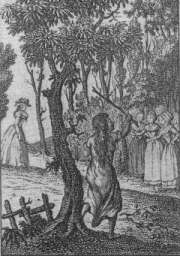Marie-Angélique Memmie Le Blanc facts for kids
Quick facts for kids
Marie-Angélique Memmie Le Blanc
|
|
|---|---|
 |
|
| Born |
Birth name unknown
1712 |
| Died | December 15, 1775 (aged 63) |
| Other names | The Wild Girl of Champagne The Maid of Châlons The Wild Child of Songy |
Marie-Angélique Memmie Le Blanc (born around 1712 in what is now Wisconsin, United States – died December 15, 1775, in Paris, France) was a famous "wild child" from the 1700s in France. A wild child, also known as a feral child, is a human child who has lived away from human contact from a very young age, and has little or no experience of human care, loving or social behavior, and, crucially, of human language. She was known by several names, including The Wild Girl of Champagne and The Maid of Châlons.
Some modern experts have wondered if her story was completely true or partly made up. However, in 2004, a French writer named Serge Aroles said it was real. He spent ten years looking through old records from France and America to prove it.
Aroles believes Marie-Angélique lived alone in the forests of France for ten years, from when she was about nine until she was 19. Villagers found her in Songy, Champagne, in September 1731. He thinks she was born in 1712 as a Native American from the Meskwaki people in what is now Wisconsin. She passed away in Paris in 1775, at 63 years old. Aroles found old papers that show she learned to read and write as an adult. This is very unusual for wild children.
Contents
How We Know Her Story
The story of Marie-Angélique's time in the wild became well-known in the mid-1700s. A French writer named Marie-Catherine Homassel Hecquet wrote a short book about her in 1755. It was edited by a French scientist, Charles Marie de La Condamine. This book was later translated into English in 1768, called An Account of a Savage Girl, Caught Wild in the Woods of Champagne. The book said Marie-Angélique was ten when she was found, but experts now think she was 19.
Many important people met Marie-Angélique and wrote about her. These included a French royal family member, Charles-Philippe d’Albert, Duc de Luynes, in 1753. The French poet Louis Racine also wrote about her around 1755. A Scottish thinker named James Burnett, Lord Monboddo interviewed her in 1765. Other naturalists and historians also published accounts of her life.
About Marie-Catherine Homassel Hecquet
Marie-Catherine Homassel-Hecquet (1686–1764) was a French writer. She wrote the book about Marie-Angélique Memmie Le Blanc in 1755. The book was called Histoire d'une jeune fille sauvage trouvée dans les bois à l’âge de dix ans. It was sold in Paris to help Marie-Angélique earn some money.
It's not fully clear how much of the book Hecquet wrote herself. Some people thought the scientist Charles Marie de La Condamine wrote it, but he said he didn't. La Condamine described Hecquet as a widow who became friends with Marie-Angélique and decided to write her story. We don't know much else about Hecquet, except that she was friends with a nun in Quebec, Canada.
What Experts Say Today
Marie-Angélique's story was mostly forgotten for a long time, especially outside of France. But recently, it has gained more attention. Julia Douthwaite wrote a book about her in 2002. French radio channels also talked about her in 2011 and 2012.
The French writer Serge Aroles wrote about Marie-Angélique in his 2007 book, L’Enigme des enfants-loups. He believes she is the only wild child known to have lived in forests for ten years without serious harm to her body or mind.
Aroles' research suggests Marie-Angélique was a Native American from the "Fox" people. She was brought to France from Canada by a woman. They arrived in Marseille during a terrible sickness in 1720. Marie-Angélique escaped the sickness and walked thousands of kilometers through French forests. She was found in 1731 in Champagne.
During her ten years in the wild, she didn't live with wolves. Instead, she fought them off with a wooden club and another sharp weapon she found. When she was captured, she had some wild habits, like kneeling to drink water. She also had quick eye movements, like someone always on alert. But the most amazing thing was that she learned to speak again after ten years of not talking.
Even though Aroles thinks she was 19 when captured, the first book said she was ten. Marie-Angélique's life improved greatly. She learned to read and write. For a while, she lived in a royal abbey as a nun. Later, she faced financial difficulties but was helped by the Queen of France, the wife of King Louis XV. She died with some wealth, as shown by records of her belongings.
The Scottish philosopher James Burnett, Lord Monboddo, who met her in 1765, thought she was one of the most amazing people of his time. However, she was largely forgotten for over 200 years.
In 2015, a comic book based on Marie-Angélique's life was published in Paris. It is called Sauvage: Biographie de Marie-Angélique le Blanc.
See also
 In Spanish: Marie-Angélique Memmie Le Blanc para niños
In Spanish: Marie-Angélique Memmie Le Blanc para niños

